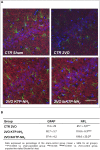Amidated and Ibuprofen-Conjugated Kyotorphins Promote Neuronal Rescue and Memory Recovery in Cerebral Hypoperfusion Dementia Model
- PMID: 26858637
- PMCID: PMC4726799
- DOI: 10.3389/fnagi.2016.00001
Amidated and Ibuprofen-Conjugated Kyotorphins Promote Neuronal Rescue and Memory Recovery in Cerebral Hypoperfusion Dementia Model
Abstract
Chronic brain ischemia is a prominent risk factor for neurological dysfunction and progression for dementias, including Alzheimer's disease (AD). In rats, permanent bilateral common carotid artery occlusion (2VO) causes a progressive neurodegeneration in the hippocampus, learning deficits and memory loss as it occurs in AD. Kyotorphin (KTP) is an endogenous antinociceptive dipeptide whose role as neuromodulator/neuroprotector has been suggested. Recently, we designed two analgesic KTP-derivatives, KTP-amide (KTP-NH2) and KTP-NH2 linked to ibuprofen (IbKTP-NH2) to improve KTP brain targeting. This study investigated the effects of KTP-derivatives on cognitive/behavioral functions (motor/spatial memory/nociception) and hippocampal pathology of female rats in chronic cerebral hypoperfusion (2VO-rat model). 2VO-animals were treated with KTP-NH2 or IbKTP-NH2 for 7 days at weeks 2 and 5 post-surgery. After behavioral testing (week 6), coronal sections of hippocampus were H&E-stained or immunolabeled for the cellular markers GFAP (astrocytes) and NFL (neurons). Our findings show that KTP-derivatives, mainly IbKTP-NH2, enhanced cognitive impairment of 2VO-animals and prevented neuronal damage in hippocampal CA1 subfield, suggesting their potential usefulness for the treatment of dementia.
Keywords: 2VO-dementia model; chronic cerebral hypoperfusion; cognitive impairment; hippocampus; kyotorphin derivatives; neuroprotection.
Figures





Similar articles
-
The Neuroprotective Action of Amidated-Kyotorphin on Amyloid β Peptide-Induced Alzheimer's Disease Pathophysiology.Front Pharmacol. 2020 Jul 9;11:985. doi: 10.3389/fphar.2020.00985. eCollection 2020. Front Pharmacol. 2020. PMID: 32733240 Free PMC article.
-
The anti-inflammatory action of the analgesic kyotorphin neuropeptide derivatives: insights of a lipid-mediated mechanism.Amino Acids. 2016 Jan;48(1):307-18. doi: 10.1007/s00726-015-2088-9. Epub 2015 Sep 7. Amino Acids. 2016. PMID: 26347373
-
Effects of acrobatic training on spatial memory and astrocytic scar in CA1 subfield of hippocampus after chronic cerebral hypoperfusion in male and female rats.Behav Brain Res. 2022 Jul 26;430:113935. doi: 10.1016/j.bbr.2022.113935. Epub 2022 May 21. Behav Brain Res. 2022. PMID: 35605797
-
Permanent, bilateral common carotid artery occlusion in the rat: a model for chronic cerebral hypoperfusion-related neurodegenerative diseases.Brain Res Rev. 2007 Apr;54(1):162-80. doi: 10.1016/j.brainresrev.2007.01.003. Epub 2007 Jan 18. Brain Res Rev. 2007. PMID: 17296232 Review.
-
[Availability of 2VO rats as a model for chronic cerebrovascular disease].Nihon Yakurigaku Zasshi. 1999 Feb;113(2):85-95. doi: 10.1254/fpj.113.85. Nihon Yakurigaku Zasshi. 1999. PMID: 10205783 Review. Japanese.
Cited by
-
The Minocycline Ameliorated the Synaptic Plasticity Impairment in Vascular Dementia.Iran J Pharm Res. 2021 Fall;20(4):435-449. doi: 10.22037/IJPR.2020.113942.14576. Iran J Pharm Res. 2021. PMID: 35194458 Free PMC article.
-
Pharmacological Potential of the Endogenous Dipeptide Kyotorphin and Selected Derivatives.Front Pharmacol. 2017 Jan 12;7:530. doi: 10.3389/fphar.2016.00530. eCollection 2016. Front Pharmacol. 2017. PMID: 28127286 Free PMC article. Review.
-
APOE4-related differences in cortical thickness are modulated by sex in middle age.Brain Imaging Behav. 2024 Oct;18(5):1163-1171. doi: 10.1007/s11682-024-00911-9. Epub 2024 Aug 28. Brain Imaging Behav. 2024. PMID: 39196521 Free PMC article.
-
(S)-Oxiracetam is the Active Ingredient in Oxiracetam that Alleviates the Cognitive Impairment Induced by Chronic Cerebral Hypoperfusion in Rats.Sci Rep. 2017 Aug 30;7(1):10052. doi: 10.1038/s41598-017-10283-4. Sci Rep. 2017. PMID: 28855592 Free PMC article.
-
The Neuroprotective Action of Amidated-Kyotorphin on Amyloid β Peptide-Induced Alzheimer's Disease Pathophysiology.Front Pharmacol. 2020 Jul 9;11:985. doi: 10.3389/fphar.2020.00985. eCollection 2020. Front Pharmacol. 2020. PMID: 32733240 Free PMC article.
References
-
- Bocheva A. I., Dzambazova-Maximova E. B. (2004). Effects of kyotorphin and analogues on nociception and pentylenetetrazole seizures. Folia Med. (Plovdiv) 46 40–44. - PubMed
LinkOut - more resources
Full Text Sources
Other Literature Sources
Miscellaneous

